
List of artificial objects on the Moon
Encyclopedia


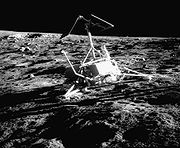
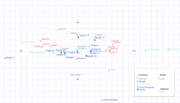
Moon
The Moon is Earth's only known natural satellite,There are a number of near-Earth asteroids including 3753 Cruithne that are co-orbital with Earth: their orbits bring them close to Earth for periods of time but then alter in the long term . These are quasi-satellites and not true moons. For more...
. The list does not include smaller objects such as the retroreflector
Retroreflector
A retroreflector is a device or surface that reflects light back to its source with a minimum scattering of light. An electromagnetic wave front is reflected back along a vector that is parallel to but opposite in direction from the wave's source. The device or surface's angle of incidence is...
s and Apollo Lunar Surface Experiment Package. Nor does it include several commemorative or personal objects left there by Apollo
Project Apollo
The Apollo program was the spaceflight effort carried out by the United States' National Aeronautics and Space Administration , that landed the first humans on Earth's Moon. Conceived during the Presidency of Dwight D. Eisenhower, Apollo began in earnest after President John F...
astronauts, such as the golf ball
Golf ball
A golf ball is a ball designed to be used in the game of golf.Under the Rules of Golf, a golf ball weighs no more than 1.620 oz , has a diameter not less than 1.680 in , and performs within specified velocity, distance, and symmetry limits...
s from Alan Shepard
Alan Shepard
Alan Bartlett Shepard, Jr. was an American naval aviator, test pilot, flag officer, and NASA astronaut who in 1961 became the second person, and the first American, in space. This Mercury flight was designed to enter space, but not to achieve orbit...
's lunar driving practice during Apollo 14
Apollo 14
Apollo 14 was the eighth manned mission in the American Apollo program, and the third to land on the Moon. It was the last of the "H missions", targeted landings with two-day stays on the Moon with two lunar EVAs, or moonwalks....
, flags, Alan Bean
Alan Bean
Alan LaVern Bean is a former NASA astronaut, engineer, and painter. Bean was selected to become an astronaut by NASA in 1963 as part of Astronaut Group 3. He made his first flight into space aboard Apollo 12, the second manned mission to land on the Moon, at the age of thirty-seven years in...
's silver astronaut pin, or the Fallen Astronaut
Fallen Astronaut
Fallen Astronaut is an 8.5 cm aluminium sculpture of an astronaut in a spacesuit which commemorates astronauts and cosmonauts who died in the advancement of space exploration...
statuette left by the crew of Apollo 15
Apollo 15
Apollo 15 was the ninth manned mission in the American Apollo space program, the fourth to land on the Moon and the eighth successful manned mission. It was the first of what were termed "J missions", long duration stays on the Moon with a greater focus on science than had been possible on previous...
.
Five S-IVB
S-IVB
The S-IVB was built by the Douglas Aircraft Company and served as the third stage on the Saturn V and second stage on the Saturn IB. It had one J-2 engine...
third stages of Saturn V
Saturn V
The Saturn V was an American human-rated expendable rocket used by NASA's Apollo and Skylab programs from 1967 until 1973. A multistage liquid-fueled launch vehicle, NASA launched 13 Saturn Vs from the Kennedy Space Center, Florida with no loss of crew or payload...
rockets from the Apollo program are the heaviest pieces that were sent to the lunar surface. While mankind has transported and left over 170,000 kg of debris on the Moon, only 382 kg of the Moon
Moon rock
Moon rock describes rock that formed on the Earth's moon. The term is also loosely applied to other lunar materials collected during the course of human exploration of the Moon.The rocks collected from the Moon are measured by radiometric dating techniques...
have been taken to Earth by Apollo and Luna missions.
The only artificial objects on the Moon that are still in use are the retroreflectors for the Lunar laser ranging experiment
Lunar laser ranging experiment
The ongoing Lunar Laser Ranging Experiment measures the distance between the Earth and the Moon using laser ranging. Lasers on Earth are aimed at retroreflectors planted on the moon during the Apollo program, and the time for the reflected light to return is determined...
s left there by the Apollo 11
Apollo 11
In early 1969, Bill Anders accepted a job with the National Space Council effective in August 1969 and announced his retirement as an astronaut. At that point Ken Mattingly was moved from the support crew into parallel training with Anders as backup Command Module Pilot in case Apollo 11 was...
, 14, and 15 astronauts and by the Lunokhod 1
Lunokhod 1
Lunokhod 1 was the first of two unmanned lunar rovers landed on the Moon by the Soviet Union as part of its Lunokhod program. The spacecraft which carried Lunokhod 1 was named Luna 17...
and Lunokhod 2
Lunokhod 2
Lunokhod 2 was the second of two unmanned lunar rovers landed on the Moon by the Soviet Union as part of the Lunokhod program....
missions.
Note that objects listed as being at greater than 90 degrees east or west are on the far side of the Moon. These include Ranger 4
Ranger 4
Ranger 4 was a spacecraft of the Ranger program designed to transmit pictures of the lunar surface to Earth stations during a period of 10 minutes of flight prior to crashing upon the Moon, to rough-land a seismometer capsule on the Moon, to collect gamma-ray data in flight, to study radar...
, Lunar Orbiter 1
Lunar Orbiter 1
The Lunar Orbiter 1 robotic spacecraft, part of the Lunar Orbiter Program, was designed primarily to photograph smooth areas of the lunar surface for selection and verification of safe landing sites for the Surveyor and Apollo missions...
, Lunar Orbiter 2
Lunar Orbiter 2
The Lunar Orbiter 2 spacecraft was designed primarily to photograph smooth areas of the lunar surface for selection and verification of safe landing sites for the Surveyor and Apollo missions...
, and Lunar Orbiter 3
Lunar Orbiter 3
The Lunar Orbiter 3 was a spacecraft launched by NASA in 1967, designed primarily to photograph areas of the lunar surface for confirmation of safe landing sites for the Surveyor and Apollo missions...
.
| Artificial object | Image | Nationality | Year | Mass (kg Kilogram The kilogram or kilogramme , also known as the kilo, is the base unit of mass in the International System of Units and is defined as being equal to the mass of the International Prototype Kilogram , which is almost exactly equal to the mass of one liter of water... ) |
Status | Location | Picture from orbit |
|---|---|---|---|---|---|---|---|
| Luna 2 Luna 2 Luna 2 was the second of the Soviet Union's Luna programme spacecraft launched to the Moon. It was the first spacecraft to reach the surface of the Moon... |
USSR Soviet Union The Soviet Union , officially the Union of Soviet Socialist Republics , was a constitutionally socialist state that existed in Eurasia between 1922 and 1991.... |
1959 | 390.2 | Intent.crashed | 29.1°N 0°W | ||
| Ranger 4 Ranger 4 Ranger 4 was a spacecraft of the Ranger program designed to transmit pictures of the lunar surface to Earth stations during a period of 10 minutes of flight prior to crashing upon the Moon, to rough-land a seismometer capsule on the Moon, to collect gamma-ray data in flight, to study radar... |
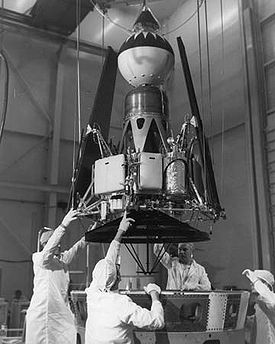 |
United States United States The United States of America is a federal constitutional republic comprising fifty states and a federal district... |
1962 | 331 | Intent.crashed | 15.5°S 229.3°E | |
| Ranger 6 Ranger 6 Ranger 6 was designed to achieve a lunar impact trajectory and to transmit high-resolution photographs of the lunar surface during the final minutes of flight up to impact. The spacecraft carried six television vidicon cameras, 2 wide angle and 4 narrow angle to accomplish these objectives... |
 |
United States | 1964 | 381 | Intent.crashed | 9.358°N 21.480°E | |
| Ranger 7 Ranger 7 Ranger 7 was the first US space probe to successfully transmit close images of the lunar surface back to Earth. It was also the first completely successful flight of the Ranger program. Launched on 28 July 1964, Ranger 7 was designed to achieve a lunar impact trajectory and to transmit... |
 |
United States | 1964 | 365.7 | Intent.crashed | 10.63°S 20.60°W | |
| Luna 5 Luna 5 Luna 5 was an unmanned space mission of the Luna program, also called Lunik 5. It was designed to continue investigations of a lunar soft landing. The retrorocket system failed, and the spacecraft impacted the lunar surface at the Sea of Clouds.... |
 |
USSR | 1965 | 1474 | Crashed | 8°N 23°W | |
| Luna 7 Luna 7 Luna 7 was an unmanned space mission of the Soviet Luna program, also called Lunik 7. The Luna 7 spacecraft was intended to achieve a soft landing on the Moon... |
 |
USSR | 1965 | 1504 | Crashed | 9.8°N 47.8°W | |
| Luna 8 Luna 8 Luna 8 , also known as Lunik 8, was a lunar space probe of the Luna program. It was launched with the objective of achieving a soft landing on the Moon. However, its retrorocket firing occurred too late, and suffered a hard impact on the lunar surface on the Oceanus Procellarum... |
 |
USSR | 1965 | 1550 | Crashed | 9.1°N 63.3°W | |
| Ranger 8 Ranger 8 Ranger 8 was a spacecraft designed to achieve a lunar impact trajectory and to transmit high-resolution photographs of the lunar surface during the final minutes of flight up to impact. The spacecraft carried six television vidicon cameras, two wide angle and four narrow angle to accomplish these... |
 |
United States | 1965 | 367 | Intent.crashed | 2.638°N 24.787°E | |
| Ranger 9 Ranger 9 Ranger 9 was designed to achieve a lunar impact trajectory and to transmit high-resolution photographs of the lunar surface during the final minutes of flight up to impact. The spacecraft carried six television vidicon cameras, 2 wide angle and 4 narrow angle to accomplish these objectives... |
 |
United States | 1965 | 367 | Intent.crashed | 12.828°S 2.387°W | |
| Luna 9 Luna 9 Luna 9 was an unmanned space mission of the Soviet Union's Luna program. On February 3, 1966 the Luna 9 spacecraft was the first spacecraft to achieve a soft landing on any planetary body other than Earth and to transmit photographic data to Earth.The automatic lunar station that achieved the... |
 |
USSR | 1966 | 1580 | Landed | 7.08°N 64.37°W | |
| Luna 10 Luna 10 Luna 10 was a Luna program, robotic spacecraft mission, also called Lunik 10.The Luna 10 spacecraft was launched towards the Moon from an Earth orbiting platform on March 31, 1966. It was the first artificial satellite of the Moon... |
 |
USSR | 1966 | 1600 | Crashed(post-mission) | ? | |
| Luna 11 Luna 11 Luna 11 was an unmanned space mission of the Soviet Union's Luna program. It is also called Lunik 11.Luna 11 was launched towards the Moon from an earth-orbiting platform and entered lunar orbit on 27 August 1966... |
USSR | 1966 | 1640 | Crashed | ? | ||
| Luna 12 Luna 12 -External links:*... |
USSR | 1966 | 1670 | Crashed | ? | ||
| Luna 13 Luna 13 -External links:* *... |
 |
USSR | 1966 | 1700 | Landed | 18.87°N 62.05°W | |
| Surveyor 1 Surveyor 1 Surveyor 1 was the first lunar soft-lander in the unmanned Surveyor program of the National Aeronautics and Space Administration . This lunar soft-lander gathered data about the lunar surface that would be needed for the manned Apollo Moon landings that began in 1969... |
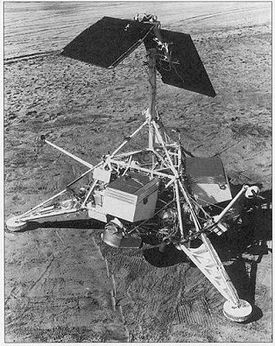 |
United States | 1966 | 270 | Landed | 2.474°S 43.339°W | LROC page |
| Lunar Orbiter 1 | .jpg) |
United States | 1966 | 386 | Crashed(post-mission) | 6.70°N 162°E | |
| Surveyor 2 Surveyor 2 Surveyor 2 was to be the second lunar lander in the unmanned American Surveyor program to explore the Moon.It was launched September 20, 1966 from Cape Kennedy, Florida aboard an Atlas-Centaur rocket.... |
 |
United States | 1966 | 292 | Crashed | 5.5°S 12°W | |
| Lunar Orbiter 2 Lunar Orbiter 2 The Lunar Orbiter 2 spacecraft was designed primarily to photograph smooth areas of the lunar surface for selection and verification of safe landing sites for the Surveyor and Apollo missions... |
.jpg) |
United States | 1966 | 385 | Crashed(post-mission) | 3.0°N 119°E | |
| Lunar Orbiter 3 Lunar Orbiter 3 The Lunar Orbiter 3 was a spacecraft launched by NASA in 1967, designed primarily to photograph areas of the lunar surface for confirmation of safe landing sites for the Surveyor and Apollo missions... |
.jpg) |
United States | 1966 | 386 | Crashed(post-mission) | 14.3°N 97.7°W | |
| Surveyor 3 Surveyor 3 Surveyor 3 was the third lander of the American unmanned Surveyor program sent to explore the surface of the Moon. Launched on April 17, 1967, Surveyor 3 landed on April 20, 1967 at the Mare Cognitum portion of the Oceanus Procellarum... |
 |
United States | 1967 | 281 | Landed | 3.015°S 23.418°W | |
| Lunar Orbiter 4 Lunar Orbiter 4 Lunar Orbiter 4 was designed to take advantage of the fact that the three previous Lunar Orbiters had completed the required needs for Apollo mapping and site selection... |
.jpg) |
United States | 1967 | 386 | Crashed(post-mission) | ? | |
| Surveyor 4 Surveyor 4 Surveyor 4 was the fourth lunar lander in the American unmanned Surveyor program sent to explore the surface of the Moon.*Launched July 14, 1967; landed July 17, 1967*Weight on landing: 625 lb... |
 |
United States | 1967 | 283 | Crashed | 0.4°N 1.33°W | |
| Explorer 35 (IMP-E) Explorer 35 Explorer 35 was a spin-stabilized spacecraft instrumented for interplanetary studies, at lunar distances, of the interplanetary plasma, magnetic field, energetic particles, and solar X rays. It was launched into an elliptical lunar orbit. The spin axis direction was nearly perpendicular to the... |
 |
United States | 1967 | 104.3 | Crashed | ? | |
| Lunar Orbiter 5 Lunar Orbiter 5 Lunar Orbiter 5, the last of the Lunar Orbiter series, was designed to take additional Apollo and Surveyor landing site photography and to take broad survey images of unphotographed parts of the Moon's far side... |
.jpg) |
United States | 1967 | 386 | Crashed(post-mission) | 3°S 83°W | |
| Surveyor 5 Surveyor 5 Surveyor 5 was the fifth lunar lander of the American unmanned Surveyor program sent to explore the surface of the Moon.*Launched September 8, 1967; landed September 11, 1967*Weight on landing: 303 kg... |
 |
United States | 1967 | 281 | Landed | 1.461°N 23.195°E | |
| Surveyor 6 Surveyor 6 Surveyor 6 was the sixth lunar lander of the American unmanned Surveyor program that reached the surface of the Moon.*Launched November 7, 1967; landed November 10, 1967*Mass on landing: 299.6 kg Surveyor 6 landed on the Sinus Medii... |
 |
United States | 1967 | 282 | Landed | 0.49°N 1.40°W | |
| Surveyor 7 Surveyor 7 Surveyor 7 was the seventh and last lunar lander of the American unmanned Surveyor program sent to explore the surface of the Moon.*Launched January 7, 1968; landed January 10, 1968*Weight on landing: 305.7 kg... |
 |
United States | 1967 | 290 | Landed | 40.86°S 11.47°W | |
| Luna 14 Luna 14 -External links:*... |
USSR | 1968 | 1670 | Crashed | ? | ||
| Apollo 10 Apollo 10 Apollo 10 was the fourth manned mission in the American Apollo space program. It was an F type mission—its purpose was to be a "dry run" for the Apollo 11 mission, testing all of the procedures and components of a Moon landing without actually landing on the Moon itself. The mission included the... LM Apollo Lunar Module The Apollo Lunar Module was the lander portion of the Apollo spacecraft built for the US Apollo program by Grumman to carry a crew of two from lunar orbit to the surface and back... (Snoopy) descent stage |
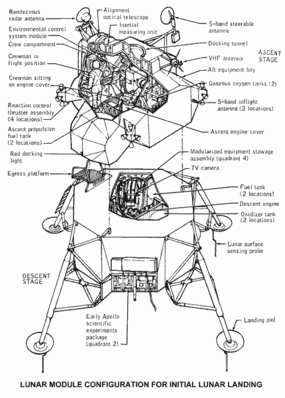 |
United States | 1969 | 2211 | Crashed | ? (post-mission) | |
| Luna 15 Luna 15 -External links:*... |
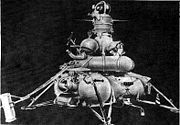 |
USSR | 1969 | 2718 | Crashed | ? | |
| Apollo 11 Apollo 11 In early 1969, Bill Anders accepted a job with the National Space Council effective in August 1969 and announced his retirement as an astronaut. At that point Ken Mattingly was moved from the support crew into parallel training with Anders as backup Command Module Pilot in case Apollo 11 was... LM-5 (Eagle) descent stage |
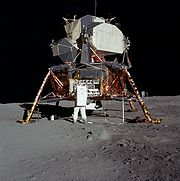 |
United States | 1969 | 2034 | Landed | 0.6741°N 23.4730°E | LROC page Image |
| Apollo 11 LM ascent stage |  |
United States | 1969 | 2184 | Crashed(post-mission) | ? | |
| Apollo 12 Apollo 12 Apollo 12 was the sixth manned flight in the American Apollo program and the second to land on the Moon . It was launched on November 14, 1969 from the Kennedy Space Center, Florida, four months after Apollo 11. Mission commander Charles "Pete" Conrad and Lunar Module Pilot Alan L... LM-6 (Intrepid) descent stage |
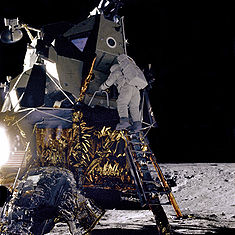 |
United States | 1969 | 2211 | Landed | 3.0124°S 23.4216°W | LROC page Image |
| Apollo 12 LM ascent stage |  |
United States | 1969 | 2164 | Intent.crashed | 3.94°S 21.20°W | |
| Luna 16 Luna 16 -External links:*... descent stage |
 |
USSR | 1970 | < 5727 | Landed | 0.68°S 56.3°E | |
| Luna 17 Luna 17 -External links:*... & Lunokhod 1 Lunokhod 1 Lunokhod 1 was the first of two unmanned lunar rovers landed on the Moon by the Soviet Union as part of its Lunokhod program. The spacecraft which carried Lunokhod 1 was named Luna 17... |
 |
USSR | 1970 | 5600 | Landed | 38.28°N 35.0°W | |
| Apollo 13 Apollo 13 Apollo 13 was the seventh manned mission in the American Apollo space program and the third intended to land on the Moon. The craft was launched on April 11, 1970, at 13:13 CST. The landing was aborted after an oxygen tank exploded two days later, crippling the service module upon which the Command... S-IVB S-IVB The S-IVB was built by the Douglas Aircraft Company and served as the third stage on the Saturn V and second stage on the Saturn IB. It had one J-2 engine... (S-IVB-508) |
United States | 1970 | 13454 | Intent.crashed | 2.75°S 27.86°W | ||
| Luna 18 Luna 18 Luna 18 was an unmanned space mission of the Luna program, also called Lunik 18.Luna 18 was placed in an earth parking orbit after it was launched and was then sent towards the Moon. On September 7, 1971, it entered lunar orbit. The spacecraft completed 85 communications sessions and 54 lunar... |
 |
USSR | 1971 | 5600 | Crashed | 3.57°N 56.5°E | |
| Luna 19 Luna 19 Luna 19 , was an unmanned space mission of the Luna program. Luna 19 extended the systematic study of lunar gravitational fields and location of mascons . It also studied the lunar radiation environment, the gamma-active lunar surface, and the solar wind... |
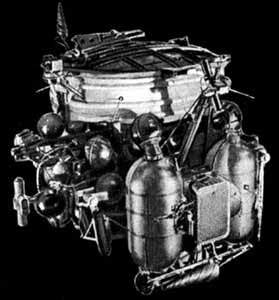 |
USSR | 1971 | 5600 | Crashed | ? | |
| Apollo 14 Apollo 14 Apollo 14 was the eighth manned mission in the American Apollo program, and the third to land on the Moon. It was the last of the "H missions", targeted landings with two-day stays on the Moon with two lunar EVAs, or moonwalks.... S-IVB (S-IVB-509) |
United States | 1971 | 14016 | Intent.crashed | 8.09°S 26.02°W | LROC page Full image |
|
| Apollo 14 Apollo 14 Apollo 14 was the eighth manned mission in the American Apollo program, and the third to land on the Moon. It was the last of the "H missions", targeted landings with two-day stays on the Moon with two lunar EVAs, or moonwalks.... LM-8 (Antares) descent stage |
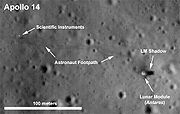 |
United States | 1971 | 2144 | Landed | 3.6453°S 17.4714°W | |
| Apollo 14 Apollo 14 Apollo 14 was the eighth manned mission in the American Apollo program, and the third to land on the Moon. It was the last of the "H missions", targeted landings with two-day stays on the Moon with two lunar EVAs, or moonwalks.... LM-8 ascent stage |
 |
United States | 1971 | 2132 | Intent.crashed | 3.42°S 19.67°W | |
| Apollo 15 Apollo 15 Apollo 15 was the ninth manned mission in the American Apollo space program, the fourth to land on the Moon and the eighth successful manned mission. It was the first of what were termed "J missions", long duration stays on the Moon with a greater focus on science than had been possible on previous... S-IVB (S-IVB-510) |
United States | 1971 | 14036 | Intent.crashed | 1.51°S 11.81°W | ||
| Apollo 15 Apollo 15 Apollo 15 was the ninth manned mission in the American Apollo space program, the fourth to land on the Moon and the eighth successful manned mission. It was the first of what were termed "J missions", long duration stays on the Moon with a greater focus on science than had been possible on previous... LM-10 (Falcon) descent stage |
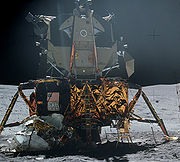 |
United States | 1971 | 2809 | Landed | 26.1322°N 3.6339°E | |
| Apollo 15 Apollo 15 Apollo 15 was the ninth manned mission in the American Apollo space program, the fourth to land on the Moon and the eighth successful manned mission. It was the first of what were termed "J missions", long duration stays on the Moon with a greater focus on science than had been possible on previous... Lunar Rover |
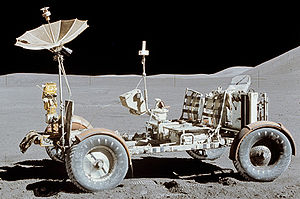 |
United States | 1971 | 462 | Landed | 26.08°N 3.66°E | |
| Apollo 15 Apollo 15 Apollo 15 was the ninth manned mission in the American Apollo space program, the fourth to land on the Moon and the eighth successful manned mission. It was the first of what were termed "J missions", long duration stays on the Moon with a greater focus on science than had been possible on previous... LM-10 ascent (Falcon) stage |
 |
United States | 1971 | 2132 | Intent.crashed | 26.36°N 0.25°E | |
| Apollo 15 subsatellite | United States | 1971 | 36 | Crashed(post-mission) | ? | ||
| Luna 20 Luna 20 Luna 20 was the second of three successful Soviet lunar sample return missions. It was flown as part of the Luna program, also called Lunik 20, as a robotic competitor to the six successful Apollo lunar sample return missions.... descent stage |
 |
USSR | 1972 | < 5727 | Landed | 3.57°N 56.5°E | |
| Apollo 16 Apollo 16 Young and Duke served as the backup crew for Apollo 13; Mattingly was slated to be the Apollo 13 command module pilot until being pulled from the mission due to his exposure to rubella through Duke.-Backup crew:... S-IVB (S-IVB-511) |
United States | 1972 | 14002 | Intent.crashed | 1.3°N 23.8°W | ||
| Apollo 16 Apollo 16 Young and Duke served as the backup crew for Apollo 13; Mattingly was slated to be the Apollo 13 command module pilot until being pulled from the mission due to his exposure to rubella through Duke.-Backup crew:... LM-11 (Orion) descent stage |
 |
United States | 1972 | 2765 | Landed | 8.9730°S 15.5002°E | |
| Apollo 16 Apollo 16 Young and Duke served as the backup crew for Apollo 13; Mattingly was slated to be the Apollo 13 command module pilot until being pulled from the mission due to his exposure to rubella through Duke.-Backup crew:... Lunar Rover |
 |
United States | 1972 | 462 | Landed | 8.97°S 15.51°E | |
| Apollo 16 Apollo 16 Young and Duke served as the backup crew for Apollo 13; Mattingly was slated to be the Apollo 13 command module pilot until being pulled from the mission due to his exposure to rubella through Duke.-Backup crew:... LM-11 (Orion) ascent stage |
 |
United States | 1972 | 2138 | Crashed(post-mission) | ? | |
| Apollo 16 subsatellite | United States | 1972 | 36 | Crashed(post-mission) | ? | ||
| Apollo 17 Apollo 17 Apollo 17 was the eleventh and final manned mission in the American Apollo space program. Launched at 12:33 a.m. EST on December 7, 1972, with a three-member crew consisting of Commander Eugene Cernan, Command Module Pilot Ronald Evans, and Lunar Module Pilot Harrison Schmitt, Apollo 17 remains the... S-IVB (S-IVB-512) |
United States | 1972 | 13960 | Intent.crashed | 4.21°S 12.31°W | ||
| Apollo 17 Apollo 17 Apollo 17 was the eleventh and final manned mission in the American Apollo space program. Launched at 12:33 a.m. EST on December 7, 1972, with a three-member crew consisting of Commander Eugene Cernan, Command Module Pilot Ronald Evans, and Lunar Module Pilot Harrison Schmitt, Apollo 17 remains the... LM-12 (Challenger) descent stage |
 |
United States | 1972 | 2798 | Landed | 20.1908°N 30.7717°E | LROC page Image |
| Apollo 17 Lunar Rover |  |
United States | 1972 | 462 | Landed | 20.17°N 30.77°E | |
| Apollo 17 Apollo 17 Apollo 17 was the eleventh and final manned mission in the American Apollo space program. Launched at 12:33 a.m. EST on December 7, 1972, with a three-member crew consisting of Commander Eugene Cernan, Command Module Pilot Ronald Evans, and Lunar Module Pilot Harrison Schmitt, Apollo 17 remains the... LM-12 (Challenger) ascent stage |
 |
United States | 1972 | 2150 | Intent.crashed | 19.96°N 30.50°E | |
| Luna 21 Luna 21 -External links:*... & Lunokhod 2 Lunokhod 2 Lunokhod 2 was the second of two unmanned lunar rovers landed on the Moon by the Soviet Union as part of the Lunokhod program.... |
 |
USSR | 1973 | 4850 | Landed | 25.85°N 30.45°E | |
| Explorer 49 Explorer 49 Explorer 49 was a 328 kilogram satellite launched on June 10, 1973 for longwave radio astronomy research. It had four 230-meter long X-shaped antenna elements, which made it one of the largest spacecraft ever built.... (RAE-B) |
United States | 1973 | 328 | Crashed | ? | ||
| Luna 22 Luna 22 Luna 22 was an unmanned space mission, part of the Soviet Luna program, also called Lunik 22.Luna 22 was a lunar orbiter mission... |
 |
USSR | 1974 | 4000 | Crashed | ? | |
| Luna 23 Luna 23 Luna 23 was an unmanned space mission of the Luna program, also called Lunik 23.Luna 23 was a Moon lander mission which was intended to return a lunar sample to Earth. Launched to the Moon by a Proton SL-12/D-1-e booster, the spacecraft was damaged during landing in Mare Crisium... |
USSR | 1974 | 5600 | Landed | ~12.75ºN, ~62.2ºE | ||
| Luna 24 Luna 24 -External links:*... descent stage |
USSR | 1976 | < 5800 | Landed | 12.75°N 62.2°E | ||
| Hagoromo / Hiten Hiten The Hiten Spacecraft , given the English name Celestial Maiden and known before launch as MUSES-A , part of the MUSES Program, was built by the Institute of Space and Astronautical Science of Japan and launched on January 24, 1990... |
 |
Japan Japan Japan is an island nation in East Asia. Located in the Pacific Ocean, it lies to the east of the Sea of Japan, China, North Korea, South Korea and Russia, stretching from the Sea of Okhotsk in the north to the East China Sea and Taiwan in the south... |
1990 | 12 | Crashed(orbit / crash not confirmed) | ? | |
| Hiten Hiten The Hiten Spacecraft , given the English name Celestial Maiden and known before launch as MUSES-A , part of the MUSES Program, was built by the Institute of Space and Astronautical Science of Japan and launched on January 24, 1990... |
 |
Japan Japan Japan is an island nation in East Asia. Located in the Pacific Ocean, it lies to the east of the Sea of Japan, China, North Korea, South Korea and Russia, stretching from the Sea of Okhotsk in the north to the East China Sea and Taiwan in the south... |
1993 | 143 | Intent.crashed | 34.3°S 55.6°E | |
| Lunar Prospector Lunar Prospector The Lunar Prospector mission was the third selected by NASA for full development and construction as part of the Discovery Program. At a cost of $62.8 million, the 19-month mission was designed for a low polar orbit investigation of the Moon, including mapping of surface composition and possible... |
 |
United States | 1998 | 126 | Intent.crashed | 87.7°S 42.35°E | |
| SMART-1 SMART-1 SMART-1 was a Swedish-designed European Space Agency satellite that orbited around the Moon. It was launched on September 27, 2003 at 23:14 UTC from the Guiana Space Centre in Kourou, French Guiana. "SMART" stands for Small Missions for Advanced Research in Technology... |
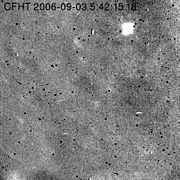 |
18 ESA European Space Agency The European Space Agency , established in 1975, is an intergovernmental organisation dedicated to the exploration of space, currently with 18 member states... nations |
2006 | 307 | Intent.crashed | 34.24°S 46.2°W | |
| Moon Impact Probe (MIP) Moon Impact Probe The Moon Impact Probe developed by the Indian Space Research Organisation , India's national space agency, was a lunar probe that was released by ISRO's Chandrayaan-1 lunar remote sensing orbiter which in turn was launched, on 22 October 2008, aboard a modified version of ISRO's Polar Satellite... / Chandrayaan-1 |
 |
India India India , officially the Republic of India , is a country in South Asia. It is the seventh-largest country by geographical area, the second-most populous country with over 1.2 billion people, and the most populous democracy in the world... |
2008 | 35 | Intent.crashed | 89°S 30°W | |
| SELENE Rstar (Okina) | Japan Japan Japan is an island nation in East Asia. Located in the Pacific Ocean, it lies to the east of the Sea of Japan, China, North Korea, South Korea and Russia, stretching from the Sea of Okhotsk in the north to the East China Sea and Taiwan in the south... |
2009 | 53 | Crashed | 28.213°N 200.967°E | ||
| Chang'e 1 |  |
China People's Republic of China China , officially the People's Republic of China , is the most populous country in the world, with over 1.3 billion citizens. Located in East Asia, the country covers approximately 9.6 million square kilometres... |
2009 | 2000 | Intent.crashed | 1.50°S 52.36°E | |
| Chandrayaan-1 |  |
India India India , officially the Republic of India , is a country in South Asia. It is the seventh-largest country by geographical area, the second-most populous country with over 1.2 billion people, and the most populous democracy in the world... |
2009 | 1,380 | Crashedduring mission | ? | |
| SELENE (Kaguya) main orbiter SELENE SELENE , better known in Japan by its nickname after the legendary Japanese moon princess, was the second Japanese lunar orbiter spacecraft. Produced by the Institute of Space and Astronautical Science and the National Space Development Agency , both now part of the Japan Aerospace Exploration... |
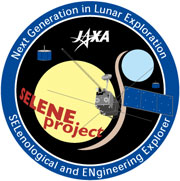 |
Japan Japan Japan is an island nation in East Asia. Located in the Pacific Ocean, it lies to the east of the Sea of Japan, China, North Korea, South Korea and Russia, stretching from the Sea of Okhotsk in the north to the East China Sea and Taiwan in the south... |
2009 | 1984 | Intent.crashed | 65.5°S 80.5°E | |
| LCROSS Shepherding Spacecraft LCROSS The Lunar Crater Observation and Sensing Satellite was a robotic spacecraft operated by NASA. The mission was conceived as a low-cost means of determining the nature of hydrogen detected at the polar regions of the moon. The main LCROSS mission objective was to explore the presence of water ice... |
United States United States The United States of America is a federal constitutional republic comprising fifty states and a federal district... |
2009 | 700 | Intent.crashed | 84.729°S 310.64°E, -3.80909 km elevation (Cabeus crater) | ||
| LCROSS Centaur Centaur (rocket stage) Centaur is a rocket stage designed for use as the upper stage of space launch vehicles. Centaur boosts its satellite payload to geosynchronous orbit or, in the case of an interplanetary space probe, to or near to escape velocity... |
United States United States The United States of America is a federal constitutional republic comprising fifty states and a federal district... |
2009 | 2270 | Intent.crashed | 84.675°S 311.275°E, -3.82693 km elevation (Cabeus crater) | ||
| Total estimated dry mass (kg) | 178,796 | ||||||
See also
- Apollo Lunar Surface Experiments PackageApollo Lunar Surface Experiments PackageThe Apollo Lunar Surface Experiments Package comprised a set of scientific instruments placed by the astronauts at the landing site of each of the five Apollo missions to land on the Moon following Apollo 11...
- List of artificial objects on extra-terrestrial surfaces
- Timeline of planetary exploration

